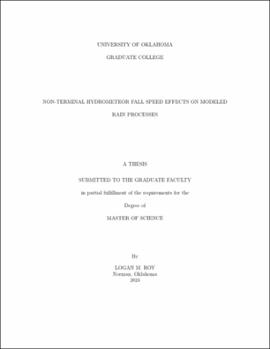| dc.description.abstract | Recent observational studies have shown hydrometeors exhibit non-terminal fall speeds. The goal of this study is to understand how these non-terminal fall speeds affect the collision, coalescence and breakup of raindrops in a Lagrangian cloud model called the Cloud Particle Model (CPM). The observational studies identified three important characteristics of the non-terminal fall speeds; 1) hydrometeor fall speeds have some variance around the expected terminal velocity; 2) hydrometeors have a tendency for large particles (D >1.5 mm) to display sub-terminal fall speeds and small particles (D < 0.5 mm) to display super-terminal fall speeds; 3) hydrometeors have the tendency for large particles to have narrower fall speed distributions than small particles. The CPM is a Lagrangian model that uses the method of limited volume (MLV) to maintain computational feasibility rather than the super droplet method commonly used in Lagrangian models. The MLV samples a fixed number of nearby particles at each time step to calculate collisional interactions rather than combine multiple particles of the same size into super droplets. This makes the CPM more sensitive to random fluctuations than the super droplet method, a desirable feature for studying random variation in fall speeds.
The first sensitivity study, varying the width of the fall speed distribution, showed that there was a critical width of the velocity variations, which if not exceeded, resulted in approached equilibrium distributions that were statistically indistinguishable from the equilibrium distributions approached using the deterministic terminal velocities. The exact value of this critical standard deviation depends strongly on the assumed initial distribution. The second sensitivity test, adding a bias term, showed the bias had a greater impact on the number concentration of large particles in the approached equilibrium distribution than the did random noise term, which means the bias has a big impact on higher moments of the size distribution like radar reflectivity and rain rate. The last sensitivity study, which scaled the variance of large particles, found that the scaling term had a very small effect on any moment of the approached equilibrium distribution, including the number concentration (7% change between scaling terms, and 18% change between bias terms) and rain rate (1.3% change between scaling terms and 5% change between bias terms), which lessens the impact of the term compared to the other two terms. | en_US |
